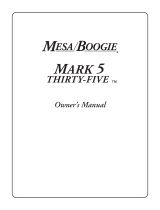Owner’s Manual
SAFETY PRECAUTIONS:
• Readtheseinstructions.
• Keeptheseinstructions.
• Heedallwarnings.
• Followallinstructions.
• Donotusethisapparatusnearwater.
• Cleanonlywithdrycloth.
• Besuretouseonlyproperlyratedpoweradaptors or
universalpowersupplies(pedalboardpowersupplies)
withappropriateattentionpaid to propervoltage,am-
perageandgroundschemes.Impropervoltage/amper-
agebeingprovidedtothepedalmaycausepoortone,
inconsistentperformance,damagetotheunitorallof
the above. Proper voltage, amperage and grounding
specsaresuppliedattheendofthismanual.
• REPLACE THE BOTTOM LID after battery replace-
ment or switch adjustment before the unit is used.
Some electronic parts inside are static sensitive and
canbedamagedfromevenasmallstaticchargefrom
contactwithcarpetorotherconductivesurfaces.Todo
an A/B comparison between BOOST and NORMAL
withthebottomremoved–playtheunitupsidedown.
DO NOT SET A POWERED UNIT “CONTROLS UP”
ONAMETAL(orany)SURFACEWITHTHEBOTTOM
REMOVED!
CongratulationsonyourchoiceofMESA/Boogieandwelcome
totheMESAFamily!Thesamepassionforexcellence,commit-
menttoqualityanddedicationtocustomersatisfactionispres-
entineachandeveryproductwemakeinourone-and-only
shopinPetaluma,California,U.S.A.Restassuredthatthevery
samepeoplethathand-buildthenestampliersintheworld
builtyourpedalandyouhaveaccessto the sameresources
forhelpthatallourcustomersdo.Callonusanytimeandenjoy!
THROTTLE BOX™
The THROTTLE BOX is all about GAIN. This beast serves
up Rock and Metal with cut and aggression but retains the
signaturewarmthandorganicsonicqualityfoundinallourin-
struments.Whileitsmainstrengthsliein theheaviersounds,
theTHROTTLEBOXisalsoversatileandthelowerregionof
the GAIN control should not be overlooked for Classic Rock
orhowlingBlues-bothrhythmandlead.Themiddlerangeof
the GAIN control delivers tight, stinging Modern Crunch with
plentyofattitudeandpercussion.Andwhenyouputthispedal
toMetal,theupperone-thirdoftheGAINcontrolunleashesa
HeavyRockhot-rodthat’sblisteringwithbothgainandsearing
top-endharmonics.
FEATURES & CONTROLS
IN: This¼”phonojackistheInstrumentInputforthede-
vice.PlugtheOutputofyourguitarintothisjackwithashielded
cableofgoodquality.Thejackisaswitchingtypejackandthe
circuitisturnedonwhenacableisinserted.Whenthecircuitis
activatedbyinsertingacable,theinternalbatteryisbeingused
topowerit–sobe sure tounplugthe cablefrom the INPUT
whenit’snotinuse.
NOTE: The internal battery is switched to an “ON” state
(drawing voltage) by a switching element in the INPUT jack.
To prolong battery life, disconnect the cable from the ¼”
INPUT jack whenever the unit is not in use.
NOTE: If you wish to leave the INPUT connected perma-
nently – as in a pedal board scenario – it is advisable to
power the unit with an external 9V power supply. When an
external (plug-in) AC 9-volt power supply is used to power
the unit the DC Receptacle on the pedal automatically dis-
connects the battery to avoid battery wear and preserve its
useful life. If you are going to use external AC power either
for long periods or permanently in a pedal board set-up,
remove the internal battery to prevent (forgotten) battery
corrosion.
OUT: This 1/4”phono jackistheOUTPUTforthedevice.
Connectthe OUTPUT tothe Input ofyour amplier- or the
INPUTofthenextdeviceinlineinyourpedalboard.
NOTE: A Word on Cables… Always use shielded instru-
ment cables of the best quality and shortest length possible
when connecting these types of devices. This will minimize
degradation of your sound, particularly high frequency
roll-off, due to the added capacitance in longer lengths of
cable. We recommend no more than 18-20 feet total (Input
and Output combined) between your instrument and the
termination at the INPUT of the amplifier. If you must use
longer cable lengths, you might consider the use of a Buffer
or Line Driver to keep the tonal integrity intact. While these
change the sound slightly, it will usually be preferable to
top end roll-off. And yes – those little 4” interconnects count
too, so count them in your cable length.
LEVEL: Thisisthemasteroutputlevelanditcontrolsthe
amountofsignalprovidedtothehostamplier.Itcanbe
usedeithertobalancelevelstocompensateforhighGAIN
settings- so thatno jump inleveloccurswhen switched
outofBYPASS.AnotherapplicationishigherLEVELset-
tingstopurposefullysendahottersignaltothehostamp
and“slam”theinputstageforincreasedclip,driveorgain.
LO/HI: The LO/HI switchincorporatedintotheGAIN
circuit creates two different gain regions or saturation
amounts.LOworksgreatforCrunchorclippedchording
andmediumgainsolosounds.HIprovidesanincreased
levelofsaturationthatisbettersuitedforreallyheavyRock
/Metalrhythmstylesandsmolderingsinglenoteleadwork.
Try the LO ModewiththeBOOST bypassedforthebest
balancewhensearchingforlowertomidgainsounds(see
BOOSTsectionlaterinthismanual).Thebalancebetween
lowendandtopendwillbemorein-syncandeven,mak-
ingthesoundsweeterand more dynamic.Checkout the
HIModewith theBOOSTengagedforhighgain applica-
tionswhereyouneedthunderous,tunedlow-endforHeavy
styles.
GAIN: Thiscontroldeterminestheamountofgain(over-
drive)inthesignalpath.
Setlow(8:00–10:30)itproducesarangeofsubtleover-
drive that’s soft and furry, yet featuring the classic mid-
punchassociatedwiththesetypesofcircuits.Thisrange
isgreatforpushedandclip-thresholdrhythmsoundsand
toaddaslightbumpforBluessolosounds.
The middle range (10:30 – 1:30) offers the most useful
regionofgainthatbeginstosaturatebutstillretainsady-
namicpunchthatkeepsnotesexpressiveandtight.This
workswell forboth Rhythm andSolo work acrossmany
stylesofmusic.
ThehighrangeoftheGAINcontrol(1:30–5:30)isallabout
thicksaturation.Thisregionwillbetheobviouschoicefor
extremeRock,MetalandHeavystylesyet,shouldnotbe
overlookedforsearingsustaininsingle-notesoloing.
MID-CUT: In addition to the standard “blend-type”
TONE control, theTHROTTLE BOX incorporates a MID
CUTcontrolthatscoopsoutthemidrangefortheclassic
Boogie“V”EQcurve.Thishasbeenanessentialingredi-
ent for the many Artists that have employed this power-
fultool on ourampliers fordecadesto get someof the
heaviest sounds around. This control works backwards
fromwhatyoumightbeusedtowithTonecontrols.Asyou
increasethecontrolyouareincreasingthe“cut”andcutting
outmoremids–untilatthemaximumsetting(5:30)there
ishardlyanymidrangeleftinthesignalpath.
TONE: This control is found on devices that do not
incorporate individual TREBLE and BASS controls. It
providessimple,globaladjustment of theentirerange of
frequencieswithonecontrol–butyourearmayperceiveit
asmostactiveontheamountofhighfrequenciespresent
inthemix.Asetting of 12:00representsa “at”setting
with highs neither boosted or cut. Increasing the TONE
controlpast 12:00 boostsa broadband of highfrequen-
cies.DecreasingtheTONEbelow12:00cuts(rollsoff)the
samespectrumofhighfrequencies.


